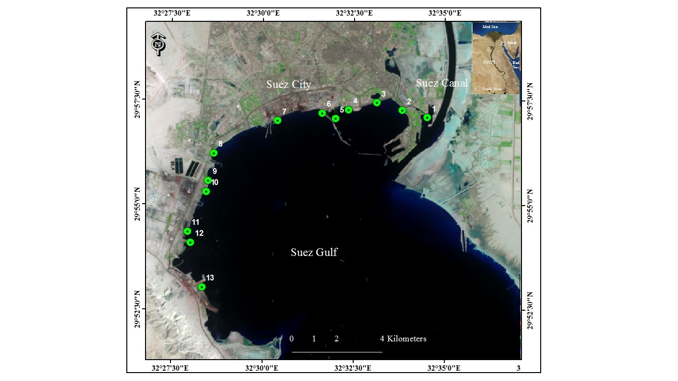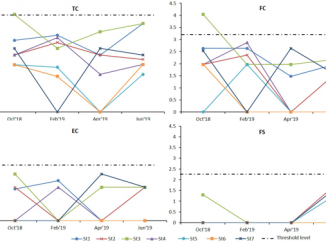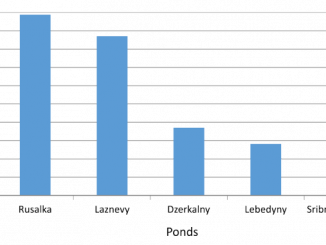
Paper category: Original research paper
Corresponding author: Randa Elmorsi (rrelmorsi@hotmail.com)
DOI: 10.2478/oandhs-2021-0032
Received: 31/03/2021
Accepted: 30/06/2021
Full text: here
Citation (APA style): Elmorsi,R.(2021).Distribution of oil, grease and polycyclic aromatic hydrocarbons in coastal water and sediments of Suez Bay. Oceanological and Hydrobiological Studies,50(4) 373-384. https://doi.org/10.2478/oandhs-2021-0032
Abstract
The permanganate index (PI), oil and grease (O&G), and 17 polycyclic aromatic hydrocarbons (PAHs) were analyzed in surface sediment and water samples collected at 13 sites along the western coast of Suez Bay (SB). PI and O&G in the SB coastal seawater ranged from 9.6 mg O2 l−1 and 17.0 mg l−1 to 16.0 mg O2 l−1 and 37.0 mg l−1, respectively. The level of polycyclic aromatic hydrocarbons (PAH) in water and sediment in the SB offshore area was determined by gas chromatography/flame ionization detection. The concentration ranged from 0.574 to 16873.2 ng g−1 in the sediment and 0.502 to 43.540 ng l−1 in water. The collected data were compared with values reported in the literature. The possible source and origin of pollution was also assessed based on the determined relative PAH levels at the study sites, the ratio of low molecular mass PAHs (LPAHs) to high molecular mass PAHs (HPAHs), and molecular indices of samples.
References
Abdallah, R.I., Khalil, N.M., & Roushdy, M.I. (2016). Monitoring of pollution in sediments of the coasts in Egyptian Red Sea. Egyptian Journal of Petroleum 25(1): 133–151. DOI: 10.1016/j.ejpe.2015.07.021.
Abou-El-Sherbini, K.S. & Hamed, M.A. (2000). Pollution assessment in aquatic ecosystem along the western coast of the Suez Bay. Egyptian J. Aquatic Biology and Fisheries 4(4): 37–59.
Adeniji, A.O., Okoh, O.O., & Okoh, A.I. (2017). Analytical methods for the determination of the distribution of total petroleum hydrocarbons in the water and sediment of aquatic systems: A review. Journal of Chemistry 2017(5178937). DOI: 10.1155/2017/5178937.
Ahmed, O. E., Mahmoud, S.A., & Mousa, A.E.R. (2015). Aliphatic and Poly-Aromatic Hydrocarbons Pollution at the Drainage Basin of Suez Oil Refinery Company. Current Science International 4(1): 27–44.
Ahmed, P.M., de Figueroa, L.I.C., & Pajot, H.F. (2020). Application of microbial consortia in degradation and detoxification of industrial pollutants. Microorganisms for Sustainable Environment and Health. INC. DOI: 10.1016/b978-0-12-819001-2.00020-6.
Al-Agroudy, N., Soliman, Y.A., Hamed, M.A. & Zaghloul, G. (2017). Distribution of PAHs in Water , Sediments Samples of Suez Canal During 2011. Journal of Aquatic Pollution and Toxicology 1(1/3): 1–10.
Ali, H.R., El-Gendy, N.S., El- Ezbewy, S., El-Gemaee, G.H., & Moustafa, Y.M. (2006). Assessment of Polycyclic Aromatic Hydrocarbons Contamination in Water, Sediment and Fish of Temsah Lake, Suez Canal, Egypt. Current World Environment 1(1): 11–22. DOI: 10.12944/cwe.1.1.03.
APHA/AWWA/WEF. (1999). Standard Methods for the Examination of Water and Wastewater. Standard Methods. American Public Health Association, American Water Works Association, Water Environment Federation. https://doi.org/ISBN 9780875532356.
Azab, A.M., Shaban, W.M., Zaki, M.S., Authman, M.M.N., & Zaher, M.F.A. (2012). Monitoring of Petroleum Hydrocarbons in Sediment and Gastropods from Suez Gulf, Red Sea. Life Science Journal 91(5): 1689–1699. DOI: 10.1017/CBO9781107415324.004.
Baumard, P., Budzinski, H. & Garrigues, P. (1998). Polycyclic aromatic hydrocarbons in sediments and mussels of the western Mediterranean sea. Environmental Toxicology and Chemistry 17(5): 765–776. DOI: 10.1002/etc.5620170501.
Belal, A.A.M. (2019). Macro-benthic invertebrates as a bio-indicator for water and sediment quality in Suez Bay, Red Sea. The Egyptian Journal of Aquatic Research 45(2): 123–130. DOI: 10.1016/j.ejar.2019.03.003.
Chen, B., Wang, Y. & Hu, D. (2010). Biosorption and biodegradation of polycyclic aromatic hydrocarbons in aqueous solutions by a consortium of white-rot fungi. Journal of Hazardous Materials 179(1–3): 845–851. DOI: 10.1016/j.jhazmat.2010.03.082.
Eed, M.A.A., Ismael, I.S. & Kaiser, M.F. (2016). Monitoring of Oil Spills along Suez-Ain Sokhna Coastal Zone, Using Remote Sensing Techniques. IOSR Journal of Environmental Science 10(2): 6–16. DOI: 10.9790/2402-10210616.
Egypt GDP : Suez Canal. (2020). https://www.ceicdata.com/en/egypt/gdp-by-industry-current-price/gdp-suez-canal
El-Agroudy, N.A., El Azim, H.A., Soliman, Y.A., Said, T.O., El Moselhy, K.M. et al. (2007). Concentrations of petroleum hydrocarbons in water and some marine organisms of the Gulf of Suez. Egyptian Journal of Aquatic Research 33(2): 128–143.
El Diasty, W.S., El Beialy, S.Y., Mostafa, A.R., El Adl, H.A. & Batten, D.J. (2017). Hydrocarbon source rock potential in the southwestern Gulf of Suez graben: Insights from organic geochemistry and palynofacies studies on well samples from the Ras El Bahar Oilfield. Marine and Petroleum Geology 80: 133–153. DOI: 10.1016/j.marpetgeo.2016.11.012.
Eladawy, A., Shaltout, M., Sousa, M.C., Dias, J.M., & Nadaoka, K. (2018). Estimating the Mean Circulation and Water Exchange of the Gulf of Suez-Red Sea via a Validated One-Way Atmospheric-Hydrodynamic Coupled Model. Earth Systems and Environment 2(2): 213–231. DOI: 10.1007/s41748-018-0049-7.
Elfadly, A.A., Ahmed, O.E. & El Nady, M.M. (2017). Assessing of organic content in surface sediments of Suez Gulf, Egypt depending on normal alkanes, terpanes and steranes biological markers indicators. Egyptian Journal of Petroleum 26(4): 969–979. DOI: 10.1016/j.ejpe.2016.11.007.
Elmorsi, R.R., El-Alfy, M.A. & Abou-El-Sherbini, K.S. (2020). Evaluation of the trophic state predicted from lab and Landsat data of western coastal water of Suez Bay, Egypt. GeoJournal. DOI: 10.1007/s10708-020-10230-3.
Emara, M.M., Farid, N.A., Ahmed, O.E. & Kamal, E.M. (2013). Physico-chemical Study of Surface Seawater in The Northwestern Gulf of Suez. Egypt. J. Chem. 56(5): 345–365.
Environmental Impact Assesment (EIA) for a Proposed Mathanol Facility in Damietta Port (Draft Report). (2006) (Vol. 20).
Goh, C.-P. & Lim, P.-E. (2008). Potassium Permanganate As Oxidant in the Cod Test for Saline Water Samples. ASEAN Journal on Science and Technology for Development 25(2): 383–393. DOI: 10.29037/ajstd.269.
Hamed, M.A., Soliman, Y.A., Khodir, A.E., Soliman, A.H., Agroudy, N.A. El, & Hussein, F. (2010). Physico-chemical characteristics of Suez Bay water during 2006-2007. Egypt J. Aquat. Biol. & Fish. 14(1): 43–56.
Hasanuzzaman, M., Ueno, A., Ito, H., Ito, Y., Yamamoto, Y. et al. (2007). Degradation of long-chain n-alkanes (C36 and C40) by Pseudomonas aeruginosa strain WatG. International Biodeterioration and Biodegradation 59(1): 40–43. DOI: 10.1016/j.ibiod.2006.07.010.
Honda, M. & Suzuki, N. (2020). Toxicities of polycyclic aromatic hydrocarbons for aquatic animals. International Journal of Environmental Research and Public Health 17(4). DOI: 10.3390/ijerph17041363.
Jaward, F.M., Alegria, H.A., Reyes, J.G.G. & Hoare, A. (2012). Levels of PAHs in the waters, sediments, and shrimps of estero de Urias, an estuary in Mexico, and their toxicological effects. The Scientific World Journal 2012. DOI: 10.1100/2012/687034.
Li, Z., Sheng, Y., Shi, W., Sun, Q., & Mortimer, R.J.G. (2016). Influence of salinity on COD measurements in coastal water management. Desalination and Water Treatment 57(39): 18338–18345. DOI: 10.1080/19443994.2015.1091996.
Lu, G.N., Dang, Z., Tao, X.Q., & Yi, X.Y. (2008). Estimation of water solubility of polycyclic aromatic hydrocarbons using quantum chemical descriptors and partial least squares. QSAR and Combinatorial Science 27(5): 618–626. DOI: 10.1002/qsar.200710014.
Mojiri, A., Zhou, J.L., Ohashi, A., Ozaki, N. & Kindaichi, T. (2019). Comprehensive review of polycyclic aromatic hydrocarbons in water sources, their effects and treatments. Science of the Total Environment 696: 133971. DOI: 10.1016/j.scitotenv.2019.133971.
Neff, J.M., Stout, S.A. & Gunster, D.G. (2005). Ecological risk assessment of polycyclic aromatic hydrocarbons in sediments: identifying sources and ecological hazard. Integrated environmental assessment and management 1(1): 22–33. DOI: 10.1897/IEAM_2004a-016.1.
Nemr, A. El, Said, T.O., Khaled, A., El-Sikaily, A. & Abd-Allah, A.M.A. (2007). The distribution and sources of polycyclic aromatic hydrocarbons in surface sediments along the Egyptian Mediterranean coast. Environmental Monitoring and Assessment 124(1–3): 343–359. DOI: 10.1007/s10661-006-9231-8.
O’Brien, P.P.Y., & Dixon, P.S. (1976). The effects of oils and oil components on algae: A review. British Phycological Journal 11(2): 115–142. DOI: 10.1080/00071617600650161.
Purcaro, G., Moret, S. & Conte, L.S. (2015). Polycyclic Aromatic Hydrocarbons. Encyclopedia of Food and Health 406–418. DOI: 10.1016/B978-0-12-384947-2.00550-X.
Said, T.O., Samra, M.I.El, Abdallah, A.M. & Agroudy, N.A.El. (2001). Dissolved Petroleum Components Along the Suez Canal. Mans. Sci. Bull. (A Chem.): 28(2): 85–99.
Soliman, Y.A., El Gawad, I.A., & Abdallah, A.M. (2017). Evaluation levels of phenols and its derivatives in suez bay seawater. Global Scientific Journal 5(12): 202.
Soliman, Y.S., Alansari, E.M.A., Sericano, J.L. & Wade, T.L. (2019). Spatio-temporal distribution and sources identifications of polycyclic aromatic hydrocarbons and their alkyl homolog in surface sediments in the central Arabian Gulf. Science of the Total Environment 658: 787–797. DOI: 10.1016/j.scitotenv.2018.12.093.
State of Oil Pollution and Management in Gulf Region. (2008). Japan International Cooperation Agency (JICA) Egyptian Environmental Affairs Agency (EEAA) (vol. 2). Regional Environmental Management Improvement Project (REMIP) working group 2 (wg2).
Steliga, T. (2012). Role of fungi in biodegradation of petroleum hydrocarbons in drill waste. Polish Journal of Environmental Studies 21(2): 471–479.
Szefer, P. (2013). Safety assessment of seafood with respect to chemical pollutants in European Seas. Oceanological and Hydrobiological Studies 42(1): 110–118. DOI: 10.2478/s13545-013-0063-1.
Tobiszewski, M. & Namieśnik, J. (2012). PAH diagnostic ratios for the identification of pollution emission sources. Environmental Pollution 162: 110–119. DOI: 10.1016/j.envpol.2011.10.025.
U.S. Environmental Protection Agency. (1999). Method 1664, Re- vision A; EPA-821-R-98-002. Washington, D.C.
Witt, M., Kobusińska, M., Maciak, J. & Niemirycz, E. (2014). Geostatistical methods for estimation of toxicity of marine bottom sediments based on the gdańsk basin area. Oceanological and Hydrobiological Studies 43(3): 247–256. DOI: 10.2478/s13545-014-0139-6.
Yan, J., Wang, L., Fu, P.P. & Yu, H. (2004). Photomutagenicity of 16 polycyclic aromatic hydrocarbons from the US EPA priority pollutant list. Mutation Research - Genetic Toxicology and Environmental Mutagenesis 557(1): 99–108. DOI: 10.1016/j.mrgentox.2003.10.004.
Yang, X., Wu, X., Hao, H. & He, Z. (2008). Mechanisms and assessment of water eutrophication. Journal of Zhejiang University SCIENCE B 9(3): 197–209. DOI: 10.1631/jzus.B0710626.
Younis, A.M., Soliman, Y.A., Elkady, E.M. & El-Naggar, M.H. (2018). Assessment of polycyclic aromatic hydrocarbons in surface sediments and some fish species from the Gulf of Suez, Egypt. Egyptian Journal of Aquatic Biology and Fisheries 22(4): 49–59. DOI: 10.21608/ejabf.2018.12472.
Zhang, J., Fan, S., Du, X., Yang, J., Wang, W. et al. (2015). Accumulation, allocation, and risk assessment of polycyclic aromatic hydrocarbons (PAHs) in soil-brassica chinensis system. PLoS ONE 10(2): 1–16. DOI: 10.1371/journal.pone.0115863.



